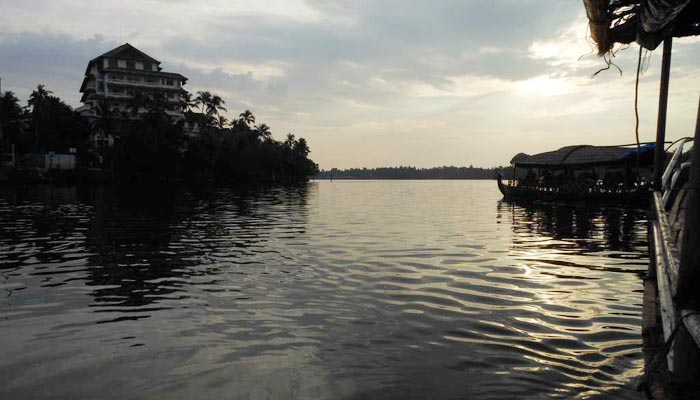The second largest lake in Kerala, Ashtamudi Lake is situated in the Kollam district. The lake runs over a length of 16 kilometres and covers almost 30% of the town of Kollam. Its name, Ashtamudi has been derived from two words 'Ashta' meaning eight and 'Mudi' meaning branch, thereby stating the fact that lake has eight branches. All the eight branches converge into a single channel that meets with the Arabian Sea. The lake is fed by the major river, Kallada. Coconut trees and palms surround the entire vicinity of the lake adding to its beauty.
The lake is laid with Chinese fishing nets to give it a different look. The banks of the lake are laden with greenery and bushes, which makes it a beautiful sight for sore eyes. It is the perfect spot to escape the city with your family and friends. The backwaters of the lake can be visited by anyone, all you need to do is hire a boat. Motorboats that range from 2 seaters to 14 seaters are available depending on the person's requirement. The eight different branches of Ashtamudi each have different names. They are Thevally Lake, Kandachira Lake, Kureepuzha Lake, Thekkumbagham Lake, Kallada Lake, Perumon Lake, Kumbalathu Lake and Kanjirottu Lake.
Flora, Fauna & Aqua Life at Ashtamudi Lake
Ashtamudi's estuary is well known to have a huge variety of mangroves, 43 to be exact out of which two species are believed to be endangered. These species help in developing the marine bio-reserve. The preservation of these species provides a scope of eco-tourism. The species are getting endangered because of the high rate of conversion of the wetlands into paddy fields.
The lake provides for 57 species of birds, 6 of which are migratory. Most of these birds are wet-land dependant birds. Terns, plovers, cormorants and herons are the most popular birds in this region. As a biosphere, the lake supports 45 species of insects, out of which 26 are butterflies. The water body is home to numerous fish and clams.
Thousands of families depend on the fish for a livelihood. It is infact known to be the second largest fish-landing centre after Vembanad lake. Ashtamudi lakes water is also home to 9 different types of phytoplanktons. This help maintain the balance in the water body and keep replenishing it from time to time. Ashtamudi Lake contributes to our environment in so many ways that it needs to be preserved and enjoyed with absolute care.
History of Ashtamudi Lake
The importance of Ashtamundi Lake and its port, Quilon has been mentioned throughout world history. Ibn Battuta, the Morrocon scholar who travelled the world, in his 24-year sojourn mentioned Quilon to be one of the five essential ports for Chinese trade. The lake has also been recorded in Persian, Chinese mandarin and Portugal history and linked with Dutch and British occupation in 1795 AD. The lake also has an importance in the Indian Struggle for Independence as Velu Thampi, and the revolutionary freedom fighter is known to have started a rebellion against the British from here.
Best Time To Visit Ashtamudi Lake
Though Ashtamudi lake is a pleasant site to visit at any time, the best time to visit the place is during sunset. The place gets a different look altogether and is worth experiencing.
How to Reach Ashtamudi Lake
The nearest railway station which lies near the lake is Kollam Junction which is approximately 2 km away. Trivandrum International Airport is the one lying nearest to the lake at a distance of about 70 km. One can further book a cab or use the local transport like autorickshaw to reach the lake.

